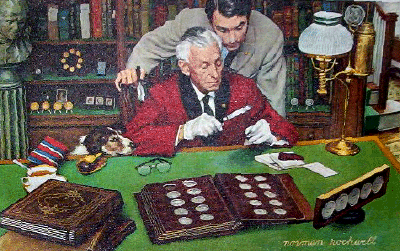
"Yankee Doodle Coins"
We have served coin collectors
around the world since 1998
Coins of the Ancient World
KINGDOM of LYDIA
Croesus, 1/3 stater
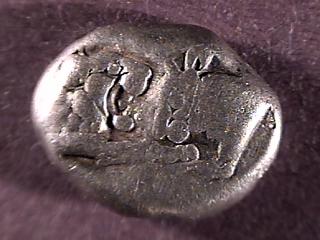
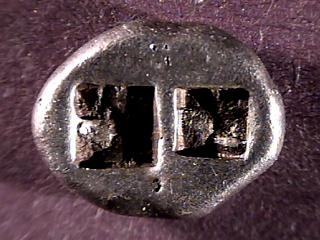
About this Coin: This particular denomination is quite scarce, perhaps being minted only in small quantities for circulation within Lydia, rather than for use as a trade coin. Although other denominations of Lydian coinage continued to be issued under later Persian rule, the Persians did not issue 1/3 staters like this one. Thus it is considered to be the earliest silver coin type, because it definitely dates to the reign of Croesus himself. Struck at Sardis, by Croesus, King of Lydia, 561-546 B.C. On the obverse are the confronting heads of a lion and a bull, while the reverse is simply two incuse punches. References: S3421, Rosen 666; Boston MFA 2071, 3.5 grams.
Historical Background: Lydia (in present-day Turkey) was an ancient kingdom, with a history dating back to about 1000 B.C., and in the 6th Century, Croesus ruled over all the cities between the Aegean coast of Asia Minor in the west and the river Halys in the East. His capital city, Sardis, was located between Mount Tmolus, and the river Hermos.
According to the Greek historian, Herodotus, "The Lydians ... so far as we have knowledge ... were the first nation to introduce the use of gold and silver coin, and the first who sold goods by retail." In the beginning, Lydia applied the King's seal to lumps of Elektron, a native metal that was a mixture of gold and silver. Although the King's seal enabled acceptance in trade among the ancients, the purity of the metal fluctuated naturally, and that made valuation difficult. King Croesus solved the problem by refining the metal, striking some staters in gold and others in silver (thus creating the first bimetallic standard).
Despite his great wealth, Croesus was destined to be the last King of Lydia. He was determined to conquer his more powerful neighbor, Persia. According to Herodotus, Croesus donated a large number of coins to the Oracle of Apollo at the Temple at Delphi, then asked the Oracle whether his invasion of Persia would be met with success. The Oracle's enigmatic reply was that if he crossed the river, he would destroy a great kingdom. Hearing what he wanted to hear, Croesus proceeded with the invasion. However, Persia's King, Cyrus the Great (580-529 BC), was the victor, and the great Kingdom Croesus destroyed turned out to be his own. Cyrus added Lydia to his empire, and his acquisition of the Lydian mints gave Persia the technology it needed to strike coins of high purity.
Didrachm, 510-480 B.C.
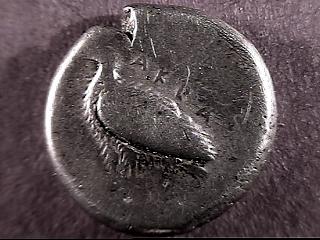
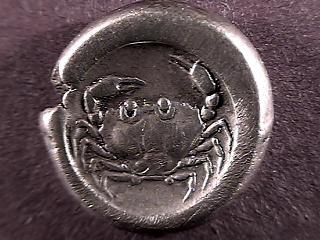
About this Coin: On the obverse is an eagle standing left, with AKRA above. The reverse has a crab, recessed in a round incuse. While the eagle is often used on coinage both ancient and modern, the crab appears on this coin as a symbol of the city, through which flowed the Akragas river, at the time teeming with crabs. References: Jenkins, Coinage of Gela, Group III; SNG ANS 939, 8.6 grams.
Historical Background: The Greek city of Akragas located in southern Sicily on the Mediterranean Sea, was later renamed by the Romans as Agrigentum, and is today the city of Agrigento, capital of the province of the same name. Today it is a tourist haven, but its past is revealed by the ruins of twenty Doric temples dating to the 6th century B.C., and an archaeological museum. It was founded by Greeks from the city of Gela about 582 B.C., toward the end of the Westward colonizing movement of the Greeks. Akragas became a center for trade and culture, home to 200,000 people, making it one of the largest Greek cities. Its location and the fertility of the land that surrounded it (grain, wine and olive oil) was what enabled it to become a center of Greek civilization, and led to its invasion, first by the Carthaginians in 406 B.C., and later by the Romans, finally falling to the consul Levinus, in 210 B.C.
Stater, c. 500 B.C.
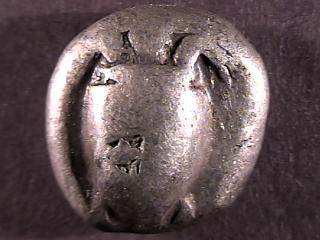
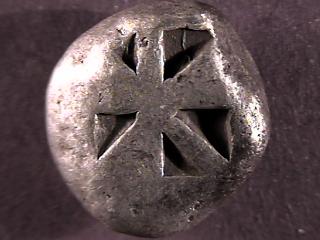
About this Coin: On the obverse is a sea turtle, with a countermark on its shell, while the reverse consists of an incuse square punch, divided into eight triangular compartments, five of which are sunken. References: S1851, Dewing.1674, 12.1 grams.
Historical Background: The Greek Island of Aegina, just off the coast of Athens, was strategically located, and was settled early (perhaps 5,000 years ago). Its recorded history begins in 950 B.C., when the Dorians, from Epidavros, conquered it. Aegina became prominent as a center for ocean-borne trading, but its location made the island a prize for conquest over the centuries, by Rome, Venice, Turkey, and pirates.
To facilitate trade, Aegina soon followed Lydia's example, becoming one of the earliest producers of stamped silver coins, using silver imported from North Africa. Like Lydia, which adopted a lion and a bull for its design, Aegina's staters also featured an animal. The image of a sea turtle was perhaps chosen according to Greek mythology, (or more likely) simply because these turtles were abundant near Aegina, as they still are today.
Tetradrachm, after 449 B.C.
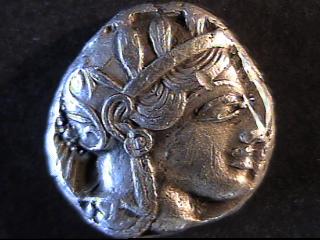
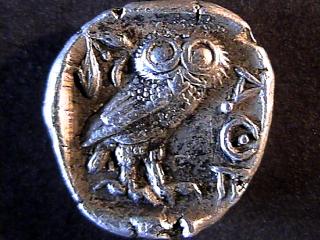
About this Coin: On the obverse is Athena, daughter of Zeus, and goddess of wisdom and agriculture, with an almond shaped eye, and wearing a crested helmet ornamented with a floral design and three olive leaves. On the reverse, an owl stands right, head facing, with a crescent moon above. The helmet's floral design and the crescent moon are believed to commemorate the great victory of the Athenians over the Persians at Marathon in 490 B.C., and possibly the League's 481 B.C. defeat of Persia in the naval battle off the island of Salamis. Reference: SNG Copenhagen 31ff, 17.0 grams.
Historical Background: Athens derived its name from the goddess Athena, who, according to Greek mythology, created the olive tree, and gave it to Athens, enabling it to become a city of great wealth. It was one of the first Greek city-states to produce silver coins that facilitated trade among the ancients. Its Tetradrachm, like the Turtle stater of Aegina, retained its basic design (adopted in 449 B.C.) for decades, and its high value meant that it was hoarded as a sign of wealth, rather than circulating, which is why many of these hoarded coins survive today in excellent condition.
The coinage of Athens was needed to cover the costs of its military forces. Athens defended other Greek cities (the Delian League), for a price: 460 talents (26,000 pounds) of silver per year. Later, Pericles increased the Delian League's assessment to 600 talents of silver, and he spent the extra money not on defense, but on public works, in particular the buildings which still stand on the Acropolis. The other Greek cities had no choice but to pay, since they had disbanded their armies.
However, the tyranny of Athens eventually led to the Peloponnesian war and a siege by Sparta that resulted in a plague in 430 B.C., and the death of Pericles, in 429 B.C. Athens then raised the assessment to 1300 talents per year, but Sparta eventually prevailed, in naval victories by Lysander of Sparta in 406 B.C., with total disaster in 404 B.C. with the loss of 200 ships, and the fall of Athens to Sparta in September of that year.
Stater, c. 350-250 B.C.
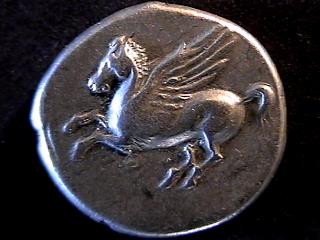
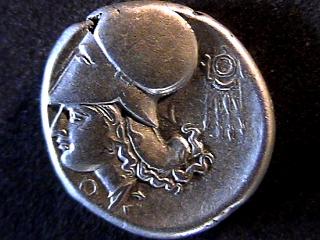
About this Coin: On the obverse is Pegasos, flying left, Q below, with a helmeted head of Athena on the reverse, facing left, a pendant earring behind, and LU at base of her neck. Reference: Pegasi II pg. 515, 13, 8.5 grams.
Historical Background: Although similar to the more common type of this coin issued by Corinth, this coinage was produced at a small town in Akarnania, named Thyrrheion, about which there is little documented history. Much more has been written about Pegasos, the last of the winged horses. Pegasos was able to cause fresh water fountains, such as Hippokrene (the fountain of the Muses, associated with poetic inspiration), to gush forth from the rocks with a stroke of his hoof. The Corinthian coinage, and this type, evidently relates to the myth of Bellerophon and Pegasos, and Athena, who came to Bellerophon in a vision and gave him a golden bridle, allowing him to subdue Pegasos. Bellerophon intended to fly to Mount Olympus, but as they flew, Zeus sent a mosquito to sting Pegasos, causing Bellerophon to be thrown from his back, and to fall to his death.
Tetradrachm, after 323 B.C.
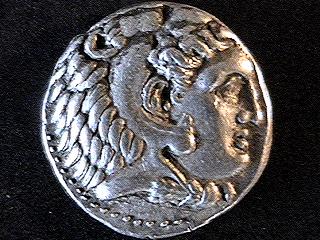
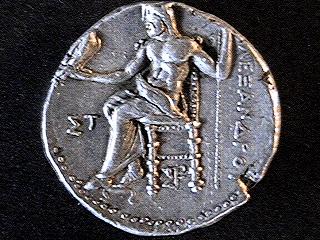
About this Coin: Struck at the Carrhae mint, after Alexander's death. On the obverse is the head of Herakles, facing right, wearing a lion's skin headdress, knotted at base of his neck. On the reverse is Zeus, father/king of the gods, enthroned facing left, holding a scepter, and an eagle on his outstretched arm, with Alexander's name in Greek, ALEXANDPOY behind. Mint mark ST in left field, and monogram SR below throne. References: Price 3802, Muller 1466, 17.2 grams.
Historical Background: Carrhae was the Biblical city of Haran, and was mentioned in Assyrian monuments as Harranu, meaning "Road". Abraham came there from Ur with his family, which remained there while he continued on to Canaan. Crassus was defeated and killed by the Parthians there, in 53 B.C.; and Emperor Galerius was also defeated there 350 years later. Prior to his war against Persia, Julian II (the Apostate) preferred to reside there instead of Edessa, because the latter was a Christian city. Harran is today a Bedouin village, with ruins of a Roman camp, churches, and a fortress dating from the Crusades. Nearby is the well where Rebecca was drawing water, when Eliezer found her.
Tetradrachm, 297-281 B.C.
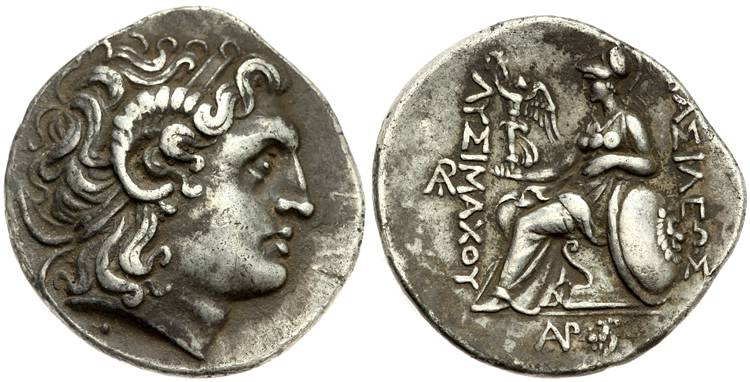
About this Coin: Struck at an uncertain mint, after Alexander's death, by King Lysimachos (or Lysimachus) of Thrace. Beginning in 297 B.C., Lysimachos struck coins honoring Alexander the Great. On the obverse, Alexander is shown facing right, diademed, with the horn of Ammon indicating his divinity. The horn of Ammon alludes to Alexander's visit to the oracle of Ammon in 331 B.C., when the god supposedly greeted Alexander as "My son." The head of Alexander, engraved with varying skill by many ancient celators, may have originated from an original gem, carved by Pyrgoteles, a court engraver who was entrusted with the production of signet rings used by Alexander. On the reverse Athena (patron goddess of Lysimachos) is seated left, holding Nike in her extended right hand, with her left arm leaning on her shield. A monogram is on the outer left, and another, with a lion's head, is in the exergue. Lysimachos' name in Greek, LYSIMAXOY is on the left, and the Greek word for King is on the right. These coins were issued by mints in Asia Minor, Macedon and Thrace, even a century after Lysimachos' death. References: Thompson -; Meydancikkake -; Müller -, 16.62 grams.
Historical Background: Lysimachos was from Thessaly, born 362-361 B.C., and served Alexander as General and as a bodyguard. After the death of Alexander in 323 B.C., Lysimachos ruled Thrace, and in 315 B.C., joined Alexander's former generals Seleucus, Ptolemy, and Cassander in a coalition against Antigonus. Lysimachos proclaimed himself king in 306 B.C., and continued fighting to expand his kingdom, eventually acquiring part of asia Minor (now Turkey) in 301 BC. and Macedonia in 286 B.C. Lysimachos came to an ignominius end, when he was killed in a battle with Seleucus at Corupedium in 281 B.C., near Magnesia ad Sipylum. This final war can be traced back to Lysimachos' wife, Arsinoë (daughter of Ptolemy I), who persuaded him to kill his son (Agathocles, from an earlier marriage). After Agathocles' death, his widow fled to safety with Seleucus, thus provoking a final war.
Sextans, 280-260 B.C.
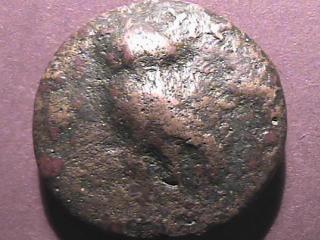
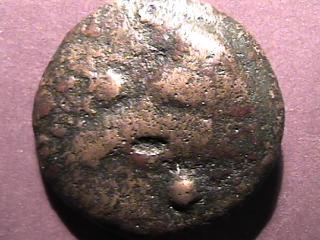
About this Coin: On the obverse is an Owl standing, facing left, with a Boar's head facing left, dividing two pellets. A very rare coin, with only six specimens known to Thurlow and Vecchi. References: RCV 574 Crawford 35/2; Sydenham 174, T&V 217, 39.76 grams. (Lot #114, Stack's Coin Galleries 11-12-03 Auction.)
Historical Background: The earliest Roman coinage followed that of the Greek colonies in Southern Italy. Issued during the Republican era, c.280-260 B.C., these coins were cast bronze pieces, with their value based on the Roman system of weights. The earliest Ases weighed a cumbersome 324 grams, equal to a Roman libra (pound). The As was divided into twelve Uncias (ounces), along with three other fractional denominations.: the Semis, equal to half an As; the Triens a third; and the Sextans a sixth, with their weights proportionate to their value. Shortly after the introduction of the bronze coinage, silver didrachms (and some drachms) were minted, in order to facilitate trade with Rome's neighbors. Cast bronze coinage continued to be issued for seven decades, but with gradually reduced weight standards, until it was replaced by struck coins, c.211 B.C., under the monetary reforms that were made necessary by the Second Punic War.
Antioch ad Orontem, Æ20, 13-14 A.D.
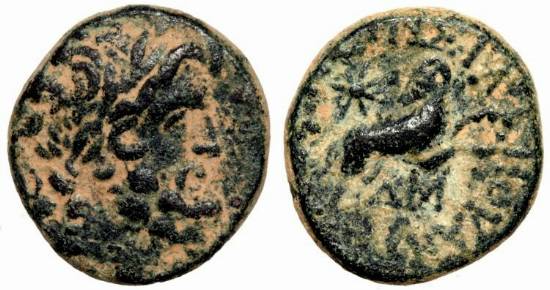
About this Coin: The final coin issued by Q. Caecilius Metellus Creticus Silanus, Legatus Augusti pro praetore of Syria, struck 13-14 A.D. Obverse: laureate head of Zeus, paramount among the Greek's gods and goddesses of Olympus. Reverse: Greek legend EPI SILANOU ANTIOCEWN, ram running right, looking looking backwards at a star, possibly the "Star of Bethlehem.", date DM (Year 44), i.e., 13 - 14 A.D. below. References: RPC I 4269; BMC Galatiaia pg 159, 65, 7.3 grams. Also see The Star of Bethlehem: The Legacy of the Magi, by Michael Molnar.
Historical Background: Astronomer Michael Molnar, in his book, The Star of Bethlehem, offers his educated opinion that the Star that led the Magi to travel to Judaea in search of the Christ child was actually the planet Jupiter, that rose as a morning star in the constellation of Aries the Ram (ancient symbol of Judaea) on April 17, 6 B.C. While other theories have held that the Star was a supernova, Molnar states that a supernova was not held to be a significant astrological event by the ancients. He also dismisses the possibility of a comet, because the ancients considered comets to be an bad omen, of death, or of war, not a good omen of the birth of a king. It is possible, however that the Star was a literary invention, many years later, when the Book of Matthew was written, to elevate the historical significance of the birth of Jesus.
Alexandria, Tetradrachm, 269-270 A.D.
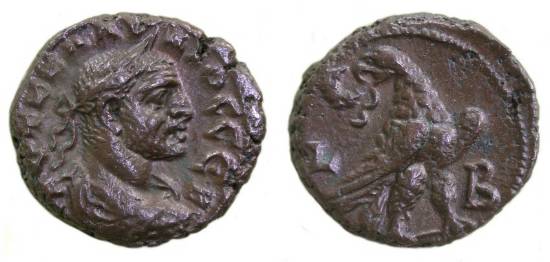
About this Coin: Claudius II ("Gothicus"), billon tetradrachm, 21mm. Obverse: laureate bust of Claudius facing right, Greek legend AVT K KLAVDIOC CEB around. Reverse: an eagle stands right, head turned left, wreath in beak, date L B (year 2 of his reign), i.e., 269-270 A.D. on either side. Alexandrian portraits like this one for Claudius were far superior to the portraits of him used on his Imperial coins that were struck in Rome. Reference: Köln 3027, 10.49 grams.
Historical Background: Claudius was a much loved Emperor, especially by his legions, for having decisively defeated the invasion from the North of the Alemanni and the Goths (thus his honorary title). This was no small feat, because the army assembled by the invaders was 320,000 strong. His reign was cut short after he contracted the plague, and died at Sirmium early in 270, at the age of 56. He was deified by the Senate.
CURRENCY: Printed by Paul Revere
Franklin's Libertas Americana Medal
Why should YOU own Gold Coins?
What our Customers say about Us
Copyright © 2016, Yankee Doodle Coins - all rights reserved